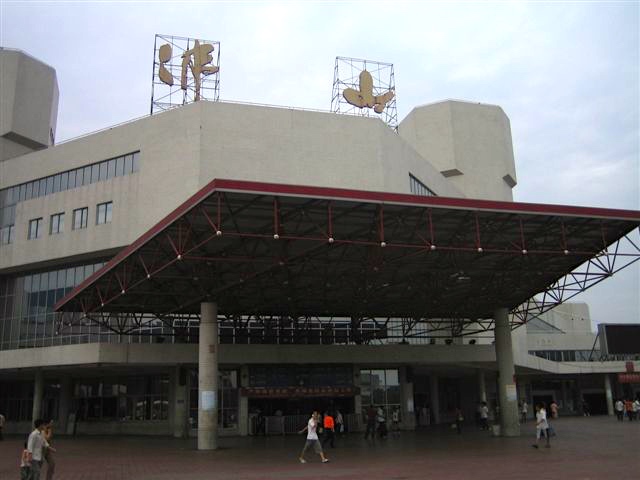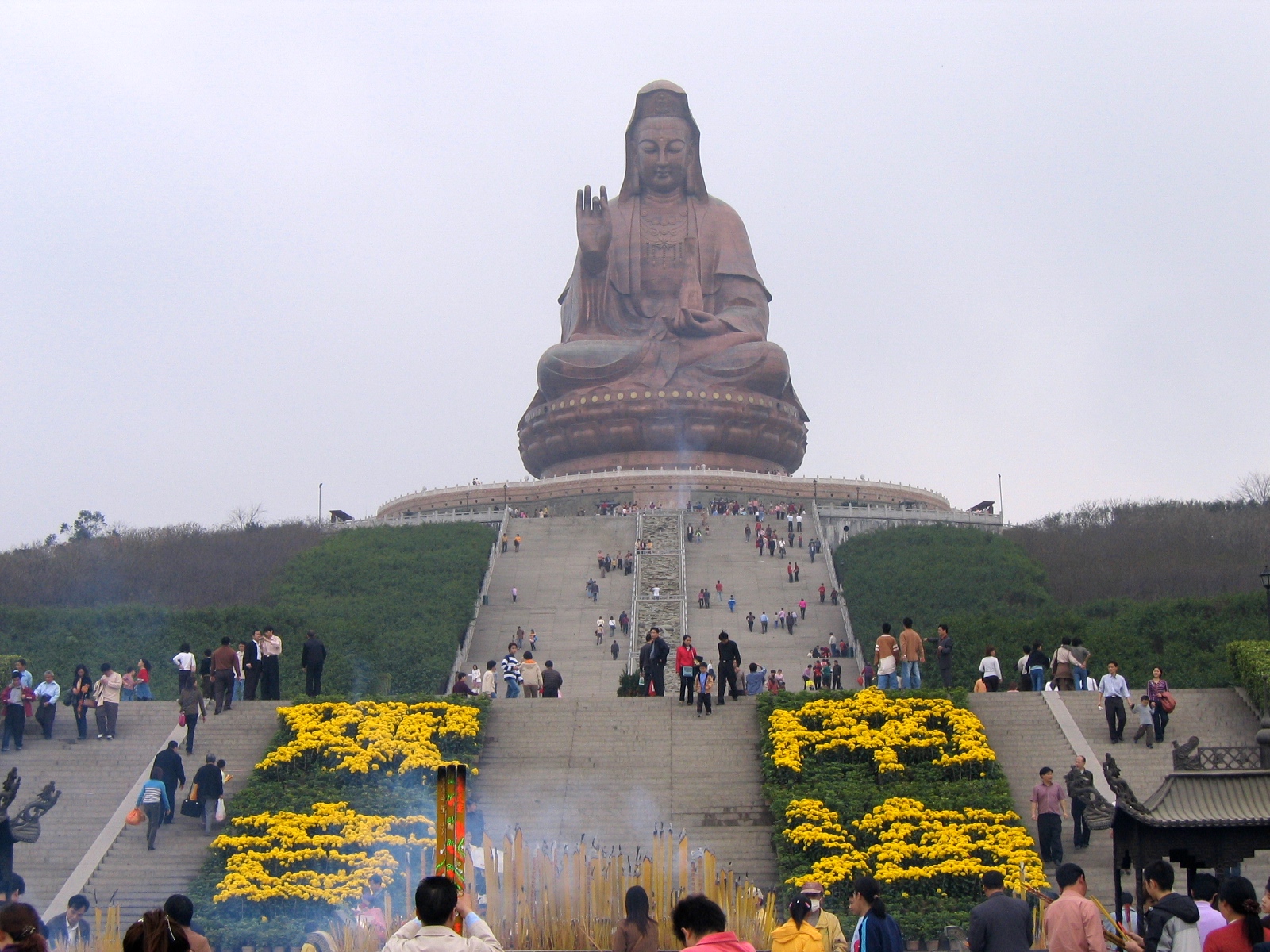|
Liwan District
Liwan District is one of 11 urban districts of the prefecture-level city of Guangzhou, the capital of Guangdong province, China. The district is split into two parts by the Pearl River: Xiguan in the northeast and Fangcun in the southwest. The area has a prominent history, dating back to the Qin dynasty, and hosts a number of major historic sites. Liwan District spans an area of , and as of the end of 2023, has a population of about 1,113,000. Toponymy Liwan District was named after "Lizhi Wan" (), which is derived from poem of "a bay of green water and red lychees along both banks". History From the Qin dynasty through the Qing dynasty, the area of present-day Liwan District belonged to Panyu County and Nanhai County. Liwan was historically located outside the western gates of Guangzhou, in an area known as Xiguan (). The district was also the site of the historic area of Huadi, at the southwest of Guangzhou's downtown area and south of Pearl River. The area of pres ... [...More Info...] [...Related Items...] OR: [Wikipedia] [Google] [Baidu] |
Postal Code Of China
Postal codes in the China, People's Republic of China () are postal codes used by China Post for the delivery of letters and goods within mainland China. China Post uses a six-digit all-numerical system with four tiers: the first tier, composed of the first two digits, show the provinces of China, province, province-equivalent direct-controlled municipalities of China, municipality, or autonomous regions of China, autonomous region; the second tier, composed of the third digit, shows the postal zone within the province, municipality or autonomous region; the fourth digit serves as the third tier, which shows the postal office within prefectures of the People's Republic of China, prefectures or prefecture-level city, prefecture-level cities; the last two digits are the fourth tier, which indicates the specific mailing area for delivery. The range 000000–009999 was originally marked for Taiwan (The Republic of China) but is not used because it not under the control of the People' ... [...More Info...] [...Related Items...] OR: [Wikipedia] [Google] [Baidu] |
Panyu, Guangzhou
Panyu, formerly romanized as Punyü, is one of 11 urban districts of the prefecture-level city of Guangzhou, the capital of Guangdong Province, China. Since January 1975, Panyu County has been under Guangzhou's administration. In 1992, Panyu County was renamed to Panyu county-level city, still under Guangzhou's administration. It was subsequently renamed to Panyu District on 10 July 2000. The present district covers an area of about . Geography Panyu lies at the heart of the Pearl River Delta. It extends from latitudes 22.26' to 23.05', and from longitudes 113.14' to 113.42'. Facing the Lion Sea in the east and the estuary of the Pearl River in the south, its eastern border is separated from Dongguan by a strip of water, and the western border of Panyu is adjacent to the cities of Nanhai, Shunde and Zhongshan, while it abuts the downtown of Guangzhou in the north. The site of the People's government of Panyu is Shiqiao which is from downtown Guangzhou and from the cities o ... [...More Info...] [...Related Items...] OR: [Wikipedia] [Google] [Baidu] |
Chinese Language
Chinese ( or ) is a group of languages spoken natively by the ethnic Han Chinese majority and List of ethnic groups in China, many minority ethnic groups in China, as well as by various communities of the Chinese diaspora. Approximately 1.39 billion people, or 17% of the global population, speak a variety of Chinese as their first language. Chinese languages form the Sinitic languages, Sinitic branch of the Sino-Tibetan language family. The spoken varieties of Chinese are usually considered by native speakers to be dialects of a single language. However, their lack of mutual intelligibility means they are sometimes considered to be separate languages in a Language family, family. Investigation of the historical relationships among the varieties of Chinese is ongoing. Currently, most classifications posit 7 to 13 main regional groups based on phonetic developments from Middle Chinese, of which the most spoken by far is Mandarin Chinese, Mandarin with 66%, or around 800&nb ... [...More Info...] [...Related Items...] OR: [Wikipedia] [Google] [Baidu] |
Typhoon
A typhoon is a tropical cyclone that develops between 180° and 100°E in the Northern Hemisphere and which produces sustained hurricane-force winds of at least . This region is referred to as the Northwestern Pacific Basin, accounting for almost one third of the world's tropical cyclones. For organizational purposes, the northern Pacific Ocean is divided into three regions: the eastern (North America to 140°W), central (140°W to 180°), and western (180° to 100°E). The Regional Specialized Meteorological Center (RSMC) for tropical cyclone forecasts is in Japan, with other tropical cyclone warning centres for the northwest Pacific in Hawaii (the Joint Typhoon Warning Center), the Philippines, and Hong Kong. Although the RSMC names each system, the main name list itself is coordinated among 18 countries that have territories threatened by typhoons each year. Within most of the northwestern Pacific, there are no official typhoon seasons as tropical cyclones form througho ... [...More Info...] [...Related Items...] OR: [Wikipedia] [Google] [Baidu] |
Foshan
Foshan (, ; Chinese: 佛山) is a prefecture-level city in central Guangdong Province, China. The entire prefecture covers and had a population of 9,498,863 as of the 2020 census. The city is part of the western side of the Pearl River Delta megalopolis, a conurbation housing 86,100,000 inhabitants, making it the biggest urban area of the world. Foshan is regarded as the home of Cantonese opera, a genre of Chinese opera; Nanquan, a martial art; and lion dancing. Name ''Fóshān'' is the pinyin romanization of the city's Chinese name , based on its Mandarin pronunciation. The Postal Map spelling "Fatshan" derives from the same name's local Cantonese pronunciation. Other romanizations include Fat-shan and Fat-shun. Foshan means " BuddhaMountain" and, despite the more famous present-day statue of Guanyin (or Kwanyin) on Mount Xiqiao, who isn't a Buddha, it refers to a smaller hill near the centre of town where three bronze sculptures of Buddha were discovered in AD ... [...More Info...] [...Related Items...] OR: [Wikipedia] [Google] [Baidu] |
Nanhai, Foshan
Nanhai District (), is a district of Foshan, Guangdong, China. Its government is the first to have developed e-government informatization at the county level in China. History Establishment of Nanhai is traditionally attributed two brothers carrying their father's bowls in 1271. They were fleeing south from the Mongols on a bamboo raft when a violent storm shipwrecked them and broke all the bowls. The brothers settled down there and the position of the wreck is commemorated by a shrine. This area was named Broken Bowls Point. On 15 February 1921, the eastern part of Nanhai County was ceded to the newly established City of Guangzhou which became part of what is now western part of Liwan. On 26 June 1951, Foshan Town (present Chancheng) was ceded to the newly established City of Foshan. Nanhai County was upgraded into a county-level city on 2 September 1992 until 8 December 2002 Nanhai was consolidated as a district of Foshan. Administration division Nanhai was a county-level ... [...More Info...] [...Related Items...] OR: [Wikipedia] [Google] [Baidu] |
Baiyun, Guangzhou
Baiyun District is one of 11 urban districts of the prefecture-level city of Guangzhou, the capital of Guangdong Province, China. The district is located in the city's northern suburbs and is named after the Baiyun Mountain (the "White Cloud Mountain"), one of the area's natural attractions. Administrative divisions There are currently 18 subdistricts and 4 towns. On 19 December 2013 four new subdistricts (Yuncheng, Helong, Baiyunhu, and Shimen) were established from carving out of existing subdistricts. History Nowadays Baiyun District was originally governed by Panyu County (now Panyu District) and Nanhai County (now Nanhai District). However, since 1924, the district changed its name as new suburb of Guangzhou (Canton) city. in June 1954, Baiyun District was formally established. Economy For many years, Guangzhou's main airport, the (Former) Guangzhou Baiyun International Airport was located within Baiyun District. In 2004, the airport was relocated farther north fr ... [...More Info...] [...Related Items...] OR: [Wikipedia] [Google] [Baidu] |
Yuexiu, Guangzhou
Yuexiu District is one of 11 urban districts and the seat of the prefecture-level city of Guangzhou, the capital of Guangdong Province, China, located west of the Tianhe District and east of the Liwan District. It is the commercial, political and cultural centre of Guangdong and noted for its high-quality education. The area has served as a regional administrative center for nearly 2,000 years, and assumed its current boundaries in September 2005. The Guangdong provincial government and the Guangzhou city government are both located in the Yuexiu District. Yuexiu District has 18 subdistricts under its jurisdiction. The total area is . According to the 2020 Chinese Census, the permanent population of Yuexiu District was 1,038,643. Toponymy The name Yuexiu comes from Yuexiu Hill. History However, according to archaeological discoveries, it has been confirmed that there were inhabitants settled in Guangzhou region at least three to four thousand years ago. The area of present-d ... [...More Info...] [...Related Items...] OR: [Wikipedia] [Google] [Baidu] |
State Council Of The People's Republic Of China
The State Council of the People's Republic of China, also known as the Central People's Government, is the chief administrative authority and national cabinet. It is constitutionally the highest administrative organ of the country and the executive organ of the National People's Congress, the highest organ of state power. It is composed of a premier, vice-premiers, state councilors, ministers, chairpersons of commissions, an auditor-general, the governor of the People's Bank of China, and a secretary-general. The premier of the State Council is responsible for the State Council and exercises overall leadership of its work. The secretary-general of the State Council, under the leadership of the premier, is responsible for handling the daily work of the State Council and heads the General Office of the State Council. The executive meeting of the State Council, consisting of the premier, vice-premiers, state councilors, and the secretary-general, is held two to three times a ... [...More Info...] [...Related Items...] OR: [Wikipedia] [Google] [Baidu] |
Production Brigade
A production brigade () was formerly the basic accounting and farm production unit in the people's commune system of the People's Republic of China. In late 1960, the unit of accounting through which labor and income were allocated was devolved from the people's commune to the production brigade. In many cases, these brigades corresponded to the high level agricultural producers' cooperatives that had preceded the people's communes. In 1962, the unit of account was further devolved to the production team, which remained the unit of account until agricultural was totally decollectivized between 1979 and 1982. See also * Work unit *Administrative divisions of the People's Republic of China The administrative divisions of China have consisted of several levels since 1412, due to mainland China's large population and geographical area. In the People's Republic of China, the constitution provides for three levels of government. ... References {{DEFAULTSORT:Production Br ... [...More Info...] [...Related Items...] OR: [Wikipedia] [Google] [Baidu] |
Fangcun District
Fangcun District () was a former district in Guangzhou, Guangdong, China. It lay to the southwest of Guangzhou's modern downtown area and south of the Pearl River. It was established in 1949 after the Chinese Communist Party took over Guangzhou from the Kuomintang. In 2005, it merged with the Liwan District. See also * Fangcun, Guangzhou *Liwan District
Liwan District is one of 11 urban districts of the prefecture-level city of Guangzhou, the capital of Guangdong province, China. The district i ...
[...More Info...] [...Related Items...] OR: [Wikipedia] [Google] [Baidu] |
Proclamation Of The People's Republic Of China
The proclamation of the People's Republic of China was made by Mao Zedong, the chairman of the Chinese Communist Party (CCP), on October 1, 1949, in Tiananmen Square in Beijing. The government of a new state under the CCP, formally called the Central People's Government, was proclaimed by Mao at the ceremony, which marked the foundation of the People's Republic of China. Previously, the CCP had proclaimed the establishment of the Chinese Soviet Republic (CSR) within the discontinuous territories of China they controlled, on November 7, 1931, in Ruijin. The CSR had lasted seven years until it was abolished in 1937. " March of the Volunteers" was played as the new national anthem, and the new national flag of the People's Republic of China (the Five-starred Red Flag) was officially unveiled to the newly founded state and hoisted for the first time during the celebrations as a 21-gun salute fired in the distance. The first public military parade of the People's Liberatio ... [...More Info...] [...Related Items...] OR: [Wikipedia] [Google] [Baidu] |




